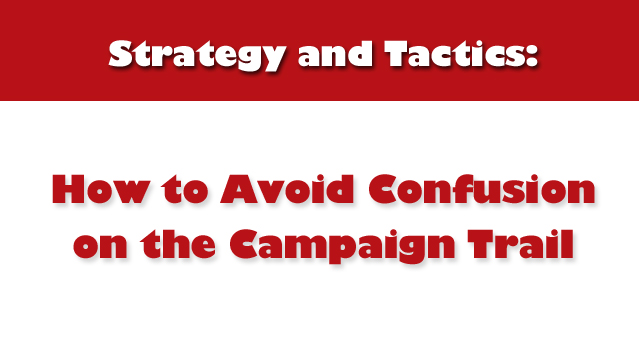Blog
Strategy and Tactics: Avoid Confusion on the Campaign Trail
July 30, 2013
 Cadets at West Point Military Academy are taught to analyze an effective mission on three separate tiers: objective, strategy, and tactics. The broad, desired end-result goal is your objective. The specific method of action to accomplish this goal is your strategy. And tactics are the various points you employ to reach your destination.
Cadets at West Point Military Academy are taught to analyze an effective mission on three separate tiers: objective, strategy, and tactics. The broad, desired end-result goal is your objective. The specific method of action to accomplish this goal is your strategy. And tactics are the various points you employ to reach your destination.
Look at any well-run campaign as an example. The objective is to earn a majority of votes, 50 percent plus 1, to win election to public office; an effective strategy would be to define yourself as the candidate who will work to improve the economy, bring needed jobs to your community; and tactics would vary from utilizing different communication techniques to disseminate your message.
Once an objective is established, every tactic your campaign employs — from all its communications, public appearances, and policy statements — must advance a consistent strategy to accomplish this goal. Every person on a campaign staff that potentially has an affect on voters must thoroughly understand, know and internalize the strategy so he or she is able to make decisions and take actions that will move the operation closer towards the objectives.

Strategic Planning
A fundamental flaw that inevitably raises its ugly head during misguided and failed attempts at elected office is when campaigns confuse strategy and tactics.
A strategy by nature must be durable, predictable, and steady — a north star in campaign operations consisting of message discipline and framing the debate favorable to your candidacy. Tactics are fluid elements that fluctuate as a campaign evolves — shifting from targeted door-to-door get-out-the vote operations to making a surprise appearance in the local media.
Effective strategies are consistent. Good tactics create surprises. Get these confused and chaos ensues.
An excellent and recent example of this occurrence is the 2004 presidential election. The Bush campaign understood that to win re-election they had to convince voters it was important to stay the course in the War on Terror, strong leadership in perilous and dangerous times. The Kerry campaign by contrast struggled to find a clear and consistent strategy, often confusing the overall message. Desperately seeking acceptance among the far Left, Kerry portrayed himself as a globalist devoted to building international consensus first and foremost; simultaneously, and paradoxically, he had a contrasting message of wanting to appear as a hawk on national defense.
Bush developed a simple strategic narrative: I am strong and decisive; my opponent is weak and uncertain. Kerry infamously “Voted for it before voting against it.” The Republican incumbent made use of effective tactics to convey a clear message to voters via mass media, public appearances, and an outstanding door-to-door operation conducted in competitive states. Kerry had multiple messages that contradicted each other, tactics that were directed at differing groups, and eventually left voters confused and unsure of where he stood on important issues. At the end of the day, voters went with whom they trusted, the candidate with a clear strategic message.
Whether you seek elected office in a your hometown or happen to find yourself in a much higher form of the political game, defining your objective, strategy and tactics is imperative to establishing a successful campaign. Separating strategy and tactics could mean the difference between ultimate success and absolute voter confusion.

